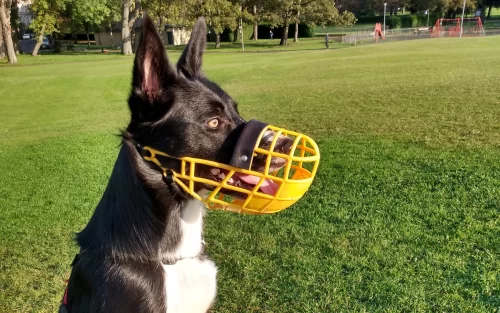Imagine you’re at your neighborhood park or perhaps the vet’s office and notice a dog sporting a muzzle. There’s a widespread misunderstanding surrounding dog muzzles, but they serve a valuable purpose in many circumstances. Here, we’ll shed some light on when and how a dog muzzle might be beneficial.
Why Consider a Dog Muzzle?
A dog muzzle is an effective training aid that can alleviate stress for you, your pet, and others around you. Dog muzzles can prevent potential harm to vets, other creatures, and people. They can be an asset during socialization and training in unfamiliar settings. A muzzle can aid in making a scared dog feel at ease and prevent potential harm or biting in case a dog escapes or if a situation intensifies beyond safe behavioral limits. Muzzles can also inhibit your dog from consuming odd things during walks or at the park.
It is crucial to note that a dog muzzle should not be used unsupervised or for prolonged periods and should not replace alternative solutions. Some muzzles can limit panting, eating, drinking, and breathing, so constantly monitor your dog while they’re wearing one.
Guidance For Muzzle Training
It’s beneficial to acclimatize every dog to wearing a muzzle, even if your dog isn’t naturally aggressive or prone to biting. A muzzle can prevent accidental biting during treatment in emergencies where your dog is in severe pain or injured.
To begin, select an appropriate muzzle. Basket muzzles are excellent for outdoor activities, allowing your dog to pant, breathe, and drink while preventing a bite. Nylon muzzles are often employed in vet settings when complete jaw restraint is needed to avoid biting and are harder to remove. Ensure the muzzle fits well without restricting breathing or blood circulation. Some muzzles are even explicitly designed for breeds with shorter or squashed noses.
To familiarize your dog with their muzzle, introduce it to them and offer a treat each time they show curiosity. Then, show your dog the muzzle and provide a treat through the opening. Gradually slip the muzzle on for a few seconds, remove it, and reward your dog. Slowly increase the duration to avoid overwhelming your dog.

Alternatives to Dog Muzzles
While muzzles are a potent tool under the right circumstances, there are times when an alternate approach is more suitable. For dogs recuperating from injury or dealing with skin conditions, consider using an Elizabethan (cone) collar, donut, or surgery recovery suit to prevent licking and chewing without hampering eating or drinking.
A crate or gated section of the house is a superior option for behavioral issues like separation anxiety or unease around guests. It ensures your dog is safely confined and away from harmful or stressful scenarios, even when left alone. Remember to provide food, water, and engaging toys.
Consulting a trainer or behaviorist is advisable if you have doubts about using a muzzle. Nevertheless, dog muzzles can be an excellent training aid to support your dog in stressful or novel situations. For more training insights, feel free to explore our guide on the best training techniques.



